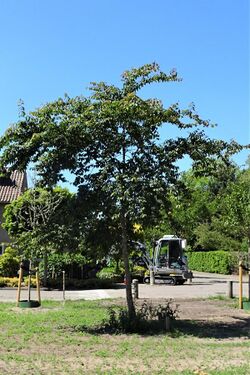Biology:Ulmus uyematsui
| Ulmus uyematsui | |
|---|---|

| |
| Ulmus uyematsui in Netherlands | |
| Scientific classification | |
| Kingdom: | Plantae |
| Clade: | Tracheophytes |
| Clade: | Angiosperms |
| Clade: | Eudicots |
| Clade: | Rosids |
| Order: | Rosales |
| Family: | Ulmaceae |
| Genus: | Ulmus |
| Subgenus: | U. subg. Ulmus |
| Section: | U. sect. Ulmus |
| Species: | U. uyematsui
|
| Binomial name | |
| Ulmus uyematsui Hayata
| |
Ulmus uyematsui Hayata, commonly known as the Alishan elm, is endemic to forests at elevations of 800–2,500 metres (2,600–8,200 ft) in Alishan, Chiayi County [3], central Taiwan,[1] where it is considered one of the minor tree species.[2][3] The tree was first named and described by the Japanese botanist Bunzō Hayata in 1913,[4] in the aftermath of the First Sino-Japanese War, when the Republic of Formosa was ceded to Japan.
Description
The tree grows to a height of 25 m with a d.b.h. to 80 cm. The bark is grey, longitudinally fissured, and exfoliates in irregular flakes. The branchlets are brown, glabrous, though pubescent when young, and devoid of corky wings. The largely glabrous leaves are elliptic to oblong-elliptic 5–11 × 3–4.5 cm wide, typically caudate at the apex; the margins are doubly serrate.[5] Unlike most elms, the leaves are equal at the base, have short (2–6 mm) petioles,[1][5] and are flushed dark-red on emergence. The perfect wind-pollinated apetalous flowers appear on second-year shoots in February, the obovate to orbicular samarae, 10–15 × 8–10 mm, on longish pedicels,[6] in March.[1]
Hayata considered the tree similar to Ulmus castaneifolia, differing only in the much thinner leaves, and absence of pubescence on the axils of the primary lateral veins.[4]
Pests and diseases
No information available.
Cultivation
U. uyematsui is rare in cultivation beyond Taiwan; it was introduced to commerce in the Netherlands in 2011. U. uyematsui was selected as one of eight tree species considered hardy enough to survive in the ecological reclamation of the Wujiazi iron mine 270 kilometres (170 mi) north-east of Beijing in Liaoning Province, China, where winter temperatures fall as low as −20 °C (−4 °F).[7] In England the species has survived temperatures as low as −16 °C (3 °F), but has succumbed to prolonged waterlogging on clay soils overwinter.[8]
Etymology
The species is named for K. Uyematsu, who collected the plant in 1913.[4]
Accessions
North America
- United States National Arboretum, Washington, D.C., US. Two small trees imported 2011. No accession details available.
Europe
- Grange Farm Arboretum [4], Lincolnshire, UK. Acc. no. 839.
- Istituto per la Protezione delle Piante, Florence, Italy. 2 small (1 m) plants, (2011).
- Royal Botanic Garden Edinburgh, UK. Acc. no. 20112233.[9]
- Royal Botanic Gardens, Kew, UK. Acc. no. not known.
- Sir Harold Hillier Gardens, Romsey, Hampshire UK. Acc. no. 2011.0267.[10]
- Wijdemeren Elm Arboretum, Frans Halslaan, Loosdrecht, Netherlands.
Nurseries
- Europe
- A Touch of Green [5], Amstelveen, Netherlands.
- Arboretum Waasland [6], Belgium.
- Henny Kolster [7] via retail nursery Mark & Rein Bulk [8], Boskoop, Netherlands.
- Pan-Global Plants [9], Frampton-on-Severn, Gloucestershire, UK.
- Asia
- Tenway Garden Center [10], Tienwei, Chonghua County, Taiwan.
References
- ↑ 1.0 1.1 1.2 Fu, L., Xin, Y. & Whittemore, A. (2002). Ulmaceae, in Wu, Z. & Raven, P. (eds) Flora of China, Vol. 5 (Ulmaceae through Basellaceae). Science Press, Beijing, and Missouri Botanical Garden Press, St. Louis, USA. ISBN:1930723407 [1]
- ↑ Hyun, S. K. (1969). White pines of Asia: Pinus koraiensis and Pinus armandii. Biology of rust resistance in forest trees. Proceedings of a NATO-IUFRO Advanced Study Institute, Aug. 17–24, 1969. University of Idaho, USA. Misc. publication 1221, p. 141. USDA, Feb. 1972.
- ↑ "Plant Name Details for Ulmus uyematsui". IPNI. http://www.ipni.org:80/ipni/idPlantNameSearch.do?id=837180-1&back_page=%2Fipni.
- ↑ 4.0 4.1 4.2 Hayata, B. (1913). Icones Plantarum Formosanarum, Vol. 3. p. 174 (1913).
- ↑ 5.0 5.1 "Leaves labelled Ulmus uyematsui in asianflora". http://www.asianflora.com/Ulmaceae/Ulmus-uyematsui.htm.
- ↑ "Herbarium specimen - L.4305450". Botany catalogues. Naturalis Biodiversity Center. http://data.biodiversitydata.nl/naturalis/specimen/L.4305450. Sheet labelled U. uyematsui, immature fruit specimen; Taiwan Forestry Research Herbarium Institute (2012)
- ↑ Li, S, Li, S-x, Liu, J, Wu, Y. (2009). Selection of vegetation species for Wujiazi iron mine ecological recovery. Journal of Hebei University of Engineering (Natural Science Edition), 2009-03. University of Hebei, China.
- ↑ Brookes, A. H. (2013). Great Fontley Elm Trial, 2013 Report. Butterfly Conservation, Hants & IoW Branch, England.
- ↑ Royal Botanic Garden Edinburgh. (2017). List of Living Accessions: Ulmus [2]
- ↑ Sir Harold Hillier Gardens. (2017). List of Living Accessions: Ulmus
External links
- efloras.org: U. uyematsui description
- efloras.org: U. uyematsui leaves and fruit illustration (figures 1 and 2)
- Photographs labelled U. uyematsui on Plant Photo Bank of China, ppbc.iplant
Wikidata ☰ Q7879641 entry
 |





